Choosing the Perfect Area Rug Size for Your Space
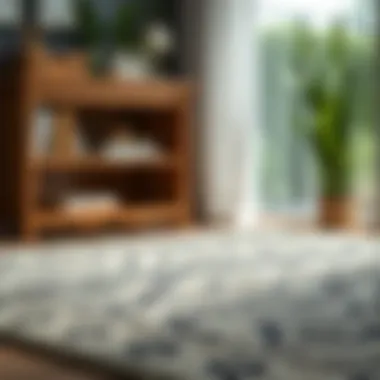
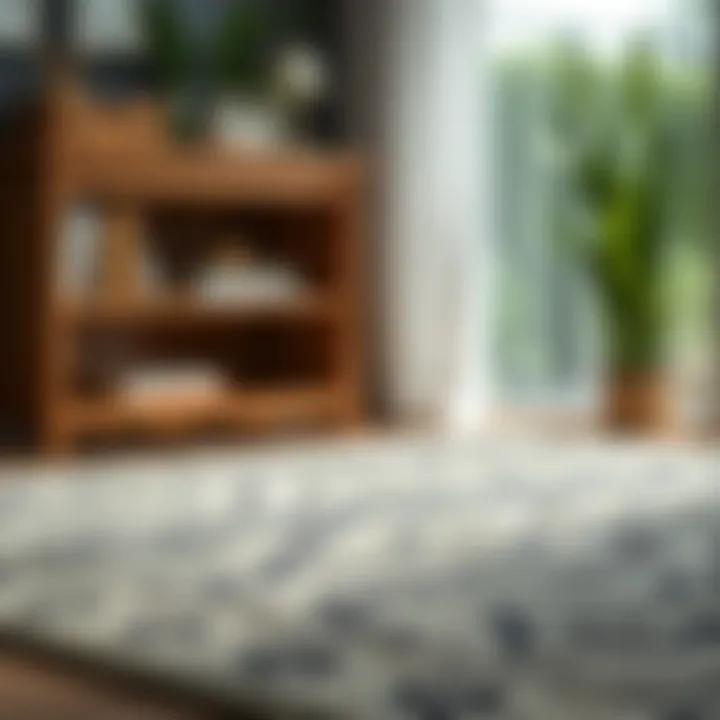
Intro
Selecting an area rug is not merely about finding a pleasing aesthetic; it’s about harmonizing spaces and creating a sense of balance in our homes. When it comes to determining the right size area rug, several factors come into play that can make or break the overall ambiance. This is especially crucial for homeowners who wish to create an inviting atmosphere, whether it’s for cozy family nights or elegant gatherings with friends.
Understanding these elements can seem daunting, but armed with the right information, anyone can elevate their interior design game. This guide aims to break down the essential considerations in choosing an area rug size that complements not just the room’s dimensions, but also the existing furniture, design elements, and personal tastes.
Design Inspirations
When one embarks on the journey to find the perfect area rug, seeking inspiration can serve as a powerful tool to guide decision-making.
Trending Styles
Currently, several styles dominate the area rug scene, offering something for every palate.
- Bohemian Chic: Characterized by bold patterns and vibrant colors, this style encourages layers and mixing textures.
- Modern Minimalism: Simple color palettes and clean lines define this aesthetic. Think geometric patterns and subtle hues that add sophistication without overwhelming.
- Rustic Farmhouse: Here, you see natural fibers and distressed looks. Think of earth tones that breathe warmth into your spaces.
Each of these styles can influence not just the rug but also the overall feeling of your home. For instance, a Bohemian rug can instantly lift a bland room, while a minimalist choice can provide a calming backdrop.
Color Palettes
Color can dramatically alter perception in any room. Understanding popular color schemes can help in choosing an area rug that complements existing decor. Here are a few approaches:
- Monochromatic: Different shades of a single color create a serene and cohesive look.
- Complementary: Contrasting colors can make specific features stand out, like a stunning sofa or artwork.
- Analogous: Using colors next to each other on the color wheel can generate harmony without sacrificing vibrancy.
"The right colors can energize a room or create calming sanctuary—choose wisely!"
Measurement Techniques
Now that design inspirations have been explored, it’s time to delve into the nitty-gritty of measurements. To ensure a rug fits seamlessly within a space, practical measurement techniques are fundamental. Here are effective methods:
- Room Dimensions: Start by measuring the length and width of the room.
- Furniture Placement: Consider where the major furniture pieces will sit. It’s common practice to choose rugs that accommodate key pieces like sofas or beds.
- Visualizing Layout: Use painter's tape to outline the desired rug size on the floor. This will help you visualize how the rug interacts with the other elements in the room.
Ultimately, measurement is not just about dimensions; it’s about ensuring that the selected rug will enhance the flow of the space
Maintaining Your Rug
Alongside choosing the right size, taking care of the rug is crucial for longevity. Whether it’s regular cleaning or a seasonal checklist, upkeep ensures your investment stands the test of time.
Seasonal Maintenance Checklist
A smart routine can keep your area rug looking fresh throughout the year:
- Spring: Deep clean to remove winter grime.
- Summer: Rotate rugs to prevent fading from direct sunlight.
- Fall: Inspect for signs of wear and address any issues early.
- Winter: Consider using a thick underlay to prevent slipping over slick floors.
Cleaning and Organization Tips
Routine care doesn’t have to be complicated. Here’s a quick overview of effective cleaning habits:
- Vacuum regularly to keep dirt and dust at bay.
- Spot clean spills immediately with proper cleaning solutions.
- Rotate your rug every few months to ensure even wear.
By integrating maintenance into your regular schedule, you can ensure your area rug remains a centerpiece of beauty and function in your home.
Understanding the Importance of Area Rugs in Interior Design
When it comes to decorating a space, area rugs often get overlooked, despite their crucial role in defining and enhancing a room's atmosphere. They can act as the glue that ties together various elements, providing a sense of warmth and comfort. In this section, we delve deep into why area rugs are not just mere floor coverings, but integral components of cohesive and functional interior designs.
Visual Cohesion and Aesthetic Appeal
Area rugs have the unique ability to bring harmony to a room. They can serve as a unifying element, bridging the gap between different styles and pieces of decor. Think about it: a vibrant Persian rug can effortlessly brighten a neutral room, while a muted jute rug can soften the sharp lines of modern furniture.
- Color Palette: The right rug can accentuate a room’s color scheme or introduce new hues, creating a pleasing visual flow. For instance, if your living room has a navy blue sofa, a rug featuring shades of blue or complementary colors can create a balanced look.
- Textures and Patterns: Rugs come in an array of textures—such as plush, flatweave, or looped—that can add depth. Using a contrasting texture, like a shag rug paired with sleek leather chairs, can create interest.
- Size and Shape: A large rug can create a defined area, making a space feel snug and inviting. For instance, in an open-plan living area, a well-placed rug can delineate the conversation space, making it feel more cohesive.
Incorporating a thoughtfully selected area rug can elevate a room's aesthetic appeal, allowing for an expressive display of personal style.
Functionality and Comfort
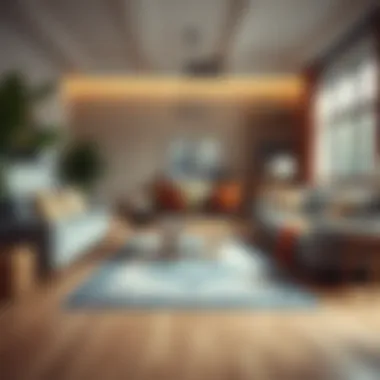
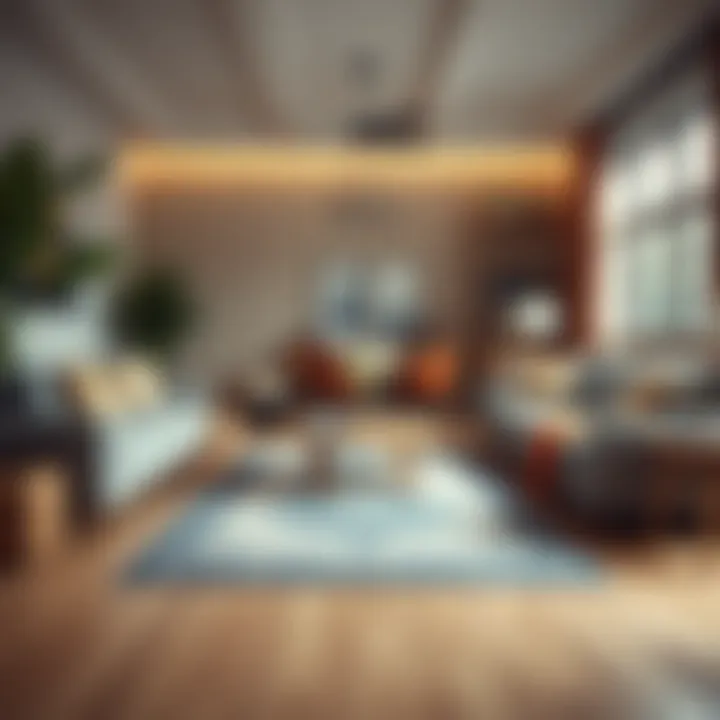
Beyond their aesthetic qualities, area rugs play a significant functional role in any space. They offer comfort underfoot and can greatly enhance the utility of the room.
- Insulation and Sound Absorption: Rugs provide thermal insulation, helping to keep a room warm during colder months. They also have sound-absorbing qualities, which can help reduce echo and excessive noise, making the space more tranquil.
- Safety Features: A rug can make slippery floors less hazardous, offering traction that protects against falls. This is particularly important in homes with young children or elderly residents.
- Comfort and Warmth: Walking barefoot on a soft rug feels more pleasant than on cold, hard surfaces. This comfort can extend to creating a welcoming environment, especially in places where people congregate, like living rooms or dining areas.
Incorporating an area rug into your design isn’t just about aesthetics; it's about crafting a warm, inviting, and functional atmosphere in your home. A well-chosen rug speaks volumes, making your space more comfortable and enjoyable, allowing your guests to feel right at home. In summary, understanding the importance of area rugs in interior design gives you the power to make informed decorating choices that enhance both style and livability.
An area rug can be a stylistic statement, comfort enhancement, and even a safety feature all in one.
Assessing Your Space
When it comes to choosing the right size area rug, understanding your space is just as crucial as selecting the rug itself. Taking the time to assess your space thoroughly can ease the decision-making process and help you create a cohesive and inviting atmosphere. An area rug does more than merely occupy a section of your floor; it should complement your existing decor, highlight essential features, and enhance the overall aesthetic. This section delves into key considerations that homeowners and design enthusiasts should keep in mind while assessing their spaces.
Analyzing Room Dimensions
First things first, getting a clear idea of the room size is paramount. Whether it’s a cozy nook or an expansive living area, the dimensions dictate what will work best. Here are some simple steps to guide your analysis:
- Measure the Width and Length: Grab a measuring tape and jot down the width and length of the room. Remember, it's all about getting precise figures. Sometimes lack of attention to detail can throw everything off.
- Consider Ceiling Height: While it might not seem related at first glance, the room's height can impact rug size choice. A low ceiling can make a large rug feel overwhelming while a high ceiling could benefit from more scale.
- Account for Architectural Features: Be mindful of any built-ins, such as fireplaces, that could affect placement, or in some cases serve as a focal point. These elements guide where your rug should go or even how large it should be.
After measuring your room, visualizing how the rug fits into your dimensions can be a useful exercise. One can lay out some tape on the floor in the outline of the potential rug to help gauge proportions before making a purchase.
Identifying Key Focal Points
Now that your dimensions are sorted, focus your attention on the room’s focal points. Every room has features that catch the eye, and where you place your rug can either enhance or detract from these elements. Consider the following:
- Highlighting Furniture: If you have a standout sofa or a gorgeous coffee table, think about how an area rug can frame that piece. A good rule of thumb is that the rug should extend beyond the legs of your furniture to create an anchored feeling.
- Creating Natural Flow: The rug can guide movement in a room, influencing how people navigate through the space. Is your room set up for conversation or for open flow? Identifying this can help in determining the rug's optimal placement.
- Playing with Heights and Textures: If your room has varying heights and textures, look to use a rug to balance those differences. A flat weave rug might complement smooth finishes, while a plush shag can soften harder surfaces.*
By pinpointing these focal areas, you not only craft a visually compelling layout but also ensure that each element in the room works harmoniously together. So, before purchasing, take a step back and envision where the rug will inhabit in relation to these key spots. Ultimately, analyzing your space can lead to thoughtful and confident decisions when it comes to your area rug selection.
Measuring for the Perfect Fit
Selecting the rightly sized area rug can turn a good room into a great one. Accurate measurement serves as the bedrock of achieving this outcome. When it comes to rugs, the right size means making a space feel balanced and inviting. Rugs can anchor furniture, provide comfort underfoot, and ground the decor by adding depth and texture. Therefore, knowing how to measure effectively is paramount to ensure a perfect fit, accentuating the overall aesthetic of the room.
To avoid missteps, it’s vital to consider not only the dimensions of the room but also how the rug interacts with existing furniture and layout. Taking exact measurements will help you visualize the impact the rug will have on the space and assist in making an informed choice.
Using Measuring Tools Effectively
While it may seem simple, measuring for a rug involves more than just grabbing a tape measure. The process can benefit greatly from several tools that enhance precision. A standard tape measure is a given for any rug sizing task. However, consider these additional tools that can help:
- Measuring wheel: Especially useful for larger spaces when trying to gauge distances.
- Graph paper: Helpful for making a scaled diagram of the room, allowing you to sketch various rug sizes and see how they will fit visually.
- Digital tools and apps: There are several apps available that can help streamline the measuring process, providing you with digital representations of your potential selections right in your space.
With these tools, you can be sure you’re measuring correctly.
Establishing Rug Boundaries
Full Coverage
When discussing full coverage, the emphasis is on the rug encompassing the entire seating area, which can range from a coffee table with all surrounding chairs to a larger setup that covers all furniture in the room. This approach to rug placement often benefits an interior by creating a unified look. One of its key characteristics is that it helps in delineating spaces, particularly in open floor plans.
By having a rug that extends under furniture, the room feels more cohesive, almost wrapping the area in comfort and style. The cozy factor increases significantly when the rug is set beneath all pieces, ensuring that even bare feet have a surface to land on, creating a warmly inviting atmosphere.
However, rolling out a large rug does come with its caveats, such as added cost and more upkeep to consider. It might not be practical for smaller spaces, where a more considerate approach could allow for a better flow.
Partial Coverage
Partial coverage is another popular approach, where the rug occupies just a specific section of the seating area instead of the whole space. This technique is advantageous when one seeks to highlight a particular area while keeping the open feel of a room. The defining characteristic here is flexibility and adaptability.
Whether you opt for a smaller rug that allows for traces of the flooring to show, or a design that compliments the furniture arrangement without overwhelming it, partial coverage can prove to be aesthetically pleasing. An example of partial coverage includes placing a rug under the coffee table, leaving other items just surrounding its edges.
One major benefit of partial coverage is that it allows homeowners to experiment with patterns and color without the commitment that a full rug might entail. Yet, the downside could be an unintended disconnect with the rest of the room if not planned meticulously, leading to a sense of a jigsaw puzzle without the final piece fitting.
In summary, both full and partial rug coverage can significantly impact the room's overall feel and function. Understanding these strategies allows homeowners to make choices that resonate with their personal interior design ethos.
Common Rug Sizes and Their Suitability
Selecting the right area rug involves more than simply choosing a design that catches the eye. Understanding common rug sizes and their suitability for different settings can be the key to striking balance and coherence within a space. Rugs serve a functional purpose, providing warmth and comfort, but they also contribute significantly to the overall aesthetic of a room. By comprehending the various standard dimensions available, homeowners can make informed decisions that harmonize with their unique spaces.
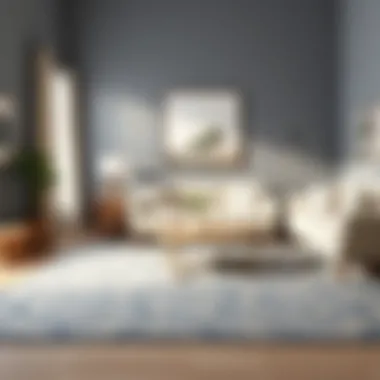
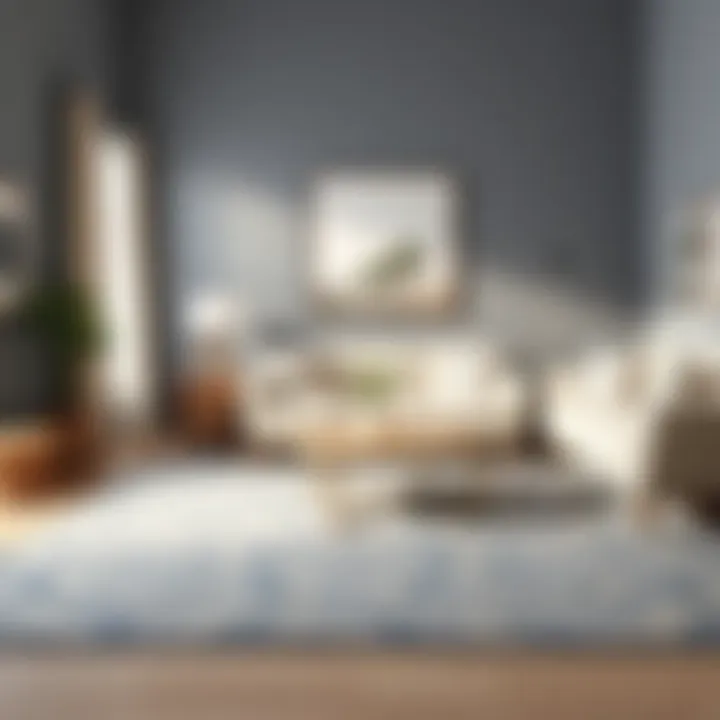
Standard Sizes and Their Uses
Area rugs come in a variety of standard sizes, each designed for specific uses within diverse room settings. Here’s a breakdown of the most commonly found dimensions:
- 2'x3': Often referred to as a "door mat rug." This size typically fits in small spaces, like the entryway, or in front of the kitchen sink. They serve to catch dirt and moisture, enhancing cleanliness while offering a touch of decor.
- 4'x6': This is a versatile size that works well in smaller living areas or as a runner. It can anchor smaller seating areas or be placed alongside a bed in a cozy nook.
- 5'x8': Ideal for defining zones in a living room, this size accommodates smaller sectional sofas or coffee tables. It creates a visually cohesive area that invites interaction.
- 8'x10': A popular choice for larger rooms, this size can successfully encompass all the furniture in a seating arrangement, allowing the front legs of sofas and chairs to rest on the rug.
- 9'x12': For expansive spaces, this size ties together various elements, ensuring that all seating options are integrated into the defined area. Perfect for spacious dining rooms or large living rooms, it enhances overall elegance.
Choosing the right standard size can dramatically influence the feel of a space. Every room configuration may require a different approach, but knowing these common measurements lays a solid foundation for your selection process.
Custom Sizes: When to Consider
While standard rug sizes are helpful, they may not always meet specific needs. This is where custom sizes come into play. Opting for a custom area rug could be your saving grace when standard dimensions fail to complement your unique corridor or oddly shaped furniture arrangement. Here are some scenarios:
- Non-standard Room Shapes: Many homes feature irregularly shaped rooms or open floor plans that require something tailored. A custom rug can fill awkward gaps and create a more unified look.
- Specific Design Needs: If you're working with high-value or unique furniture pieces, a tailor-made rug can highlight these elements without compromise. It allows for a perfect fit that accentuates the area's visual appeal.
- Commercial Spaces: Businesses often seek distinctive aesthetics that set them apart. Custom rugs can be designed to reflect a brand's identity or create a welcoming atmosphere for clients and customers.
In essence, investing in a custom-size area rug can help bridge the gap between aesthetics and functionality, ensuring that every inch of your space serves its intended purpose.
Remember, the right size rug is not just about aesthetics; it also influences the overall flow and feel of a room, affecting how spaces are navigated and experienced.
Ultimately, understanding both standard and custom rug sizes enables homeowners to coordinate their decor thoughtfully. No matter the dimension, the aim is always to create a cohesive and harmonious environment.
Rug Placement Strategies
Rug placement is not merely about laying down a piece of fabric; it’s a central aspect of defining and enhancing a room's function and style. Choosing the right placement can influence the flow of a space, guiding how people move and interact within it. Effective rug placement gives areas a sense of purpose while encouraging harmony among various elements of design. When you’re furnishing or redecorating a room, the area rug can be the thread that ties everything together, transforming a chaotic assortment of furniture into a cohesive, inviting atmosphere.
Defining Seating Areas
Creating a distinct seating area with rugs can be likened to setting boundaries in an open field. It establishes a zone for conversation, relaxation, or entertainment. To define a seating area effectively:
- Choose the right size: The rug should be large enough for at least the front legs of all seating pieces to rest on it. This connects the furniture and gives the illusion of unity.
- Keep it proportional: Ensure the rug doesn't dominate or feel out of place in relation to the room's dimensions. It should accentuate the seating arrangement, as if giving it a supportive hug.
- Maintain symmetry: Try to position the rug in such a way that creates balance. Whether it's oval, rectangular, or square, symmetry can bring a sense of calm and organization.
A well-placed rug can also help insulate sound, making the seating area more comfortable and inviting. Combining texture and color with furniture enhances the overall aesthetic appeal and promotes an atmosphere conducive to gathering. With thoughtful rug placement, you’re not just furnishing a room; you’re creating an experience.
Enhancing Pathways and Flow
Pathways are like the veins of a room, guiding both physical movement and the flow of energy. Area rugs can be strategically located to enhance these pathways, making movement intuitive while adding warmth beneath footfalls. Here’s how to think about it:
- Establish clear pathways: Rugs can guide the eye and help delineate how one area flows into another, especially in larger spaces. For instance, a runner along a hallway not only adds style but marks a clear route.
- Avoid obstruction: Ensure that rugs don’t create tripping hazards. They should lie flat and be secured to prevent slips, particularly in transition areas.
- Link different spaces: By selecting rugs that complement each other and the adjacent areas, you create visual continuity, guiding visitors smoothly from one zone to another.
Incorporating rugs to improve flow is not just practical; it can also influence how relaxing or inviting a room feels. By strategically enhancing pathways, you encourage movement within the home while adding an element of visual intrigue.
A thoughtfully placed area rug does more than anchor a room. It serves as a bridge between various design aspects and enhances how spaces connect and function.
Understanding rug placement strategies is crucial for homeowners and design enthusiasts alike. The right placement can transform a room from an ordinary space to a beautifully interconnected environment, making each area both functional and visually appealing.
Coordinating with Existing Furniture and Decor
When it comes to choosing an area rug, the interplay between the rug and your existing furniture cannot be underestimated. The right rug can act as a subtle referee in the aesthetic game of your interior design, balancing, tying together, and enhancing the various elements already present in your space. In many ways, an area rug serves as the foundation of the room, shaping its rhythm and providing an anchor for design elements.
Harmony with Color Schemes
First and foremost, color plays a pivotal role in how a room feels. A rug that harmonizes with your room's color scheme can create a sense of unity and flow. Selecting a rug that either complements or contrasts with the existing hues can influence the mood of the space significantly. If your walls are painted in a warm beige and your sofa is a deep navy, a soft, cream rug can bridge the two, introducing an element of softness while supporting both colors.
One technique to consider is using a color wheel to understand the relationships between colors. For instance, if you have a bold, patterned couch, selecting a solid color rug in one of the less dominant hues in that pattern can enhance your space without competing for attention.
It’s essential to evaluate not only the color of your furniture but also the undertones. A warm area rug can soften the look of cool-toned furnishings and vice versa. This attention to color can make all the difference, turning a haphazard arrangement into a well thought-out design.
Complementing Textures and Patterns
Moving beyond color, texture cannot be overlooked. Mixing textures adds depth and interest to your room. A plush wool rug under a sleek leather sofa or a jute rug paired with velvet cushions creates a dynamic interplay that invites touch and exploration.
The patterns of your rug should also align with those of your existing decor. If your furniture boasts bold geometrics, opting for a simpler pattern in the rug can provide a visual resting place, while still tying into the overall design. Conversely, if your decor is more subdued, a vibrant, patterned rug can inject life and energy into the room. Remember, though, that balance is key—too many competing elements can leave the eye searching for focus.
Understanding your space’s unique characteristics will also guide your rug choice. An area rug in a highly trafficked space might require different considerations than one in a seldom-used room. Selecting a durable material that can stand up to wear while still offering comforting texture will ensure longevity, marrying function with style.
"A well-coordinated rug can accentuate the best features of your space, creating harmony out of what might otherwise appear disjointed."


In summary, coordinating your area rug with existing furniture and decor involves careful consideration of color schemes and textures. Dive deep into the nuances of your space, and you'll find that the right rug is not just a piece of decor, but a crucial element in the story your room tells.
For more insights on color theory, check out Wikipedia's Color Theory Page and to explore various texture ideas, you can visit Britannica's Textile Information for context.
Visualizing Your Options
When it comes to selecting the right area rug, having a clear visual understanding is paramount. Proper visualization not only aids in grasping the impact a rug will have in your space but also helps in aligning your choices with the overall design vision. Instead of settling for guesswork, leveraging tools and strategies to visualize options can save you both time and effort. This section delves into why visualization is essential and how it can enhance your decision-making.
First, let’s discuss the benefits of visualizing your rug options. With the variety of designs, colors, and patterns available on the market, the potential for mismatches with your existing furniture is high. Visualization helps to bridge this gap by allowing you to see what a rug will look like in your actual space, rather than relying solely on your imagination.
Using Software and Apps
In today’s digital age, utilizing software and applications can significantly streamline the process of selecting an area rug. These tools enable you to input the dimensions of your room, allowing you to see how different rug sizes and styles will fit. Some popular options include RoomSketcher and Houzz.
For instance, programs like RoomClip provide a user-friendly interface where you can photograph your room, upload it, and explore various rug designs digitally placed onto your floor. This brings an added layer of realism to your planning. Consider the following points when using software:
- Customization: Many applications allow you to customize colors, textures, and even layouts, giving you a precise visualization of the impact.
- Perspective: You can often toggle views, allowing you to see how the selected rug interacts with different angles in your room.
- Integration: Some apps even provide shopping features, linking directly to retailers so you can purchase items without losing your planning momentum.
Creating a Physical Layout Plan
While digital options are advantageous, there’s something to be said about the tactile experience of physically laying out your options. This can be as straightforward as taking measurements of your room and cutting out scaled shapes of potential rugs from paper or cardboard. Here are a few steps to guide this process:
- Measure: Start with precise measurements of your room and existing furniture. Make sure to account for the layout when taking these measurements.
- Cut Out Shapes: Using graph paper or plain paper, cut out scale representations of different rug sizes. This gives you a real-world feel of how each size would occupy the space.
- Experiment: Move the cutouts around the floor where the rug will be placed. This method allows you to effectively visualize spacing, ensuring pathways and flow are maintained in your design.
"Measuring isn’t just about dimensions; it’s about understanding the harmony within your space."
These hands-on techniques can foster a better understanding of how an area rug contributes to the room's visual and functional balance. Both the technological and manual approaches offer unique advantages, and utilizing a combination of both may yield the best results.
In sum, visualizing your options is a crucial step in choosing the right area rug. Whether you opt for modern software tools or traditional layout techniques, the goal remains the same: to imagine and ultimately ask yourself how each rug will define and enhance your living space before making a purchase.
Practical Tips for Selecting the Right Area Rug
Choosing the right area rug goes beyond just the looks; it’s about fit, function and how well it complements your space. This section dissects practical tips for selecting an area rug that meets your needs, enhances aesthetic appeal and adds comfort to your home. These guidelines will help navigate through the myriad of options out there, ensuring a thoughtful decision that aligns with your lifestyle.
Considering Maintenance and Durability
When selecting a rug, the importance of maintenance and durability shouldn’t be brushed under the carpet. A rug is an investment, and like any other investment, it requires care to uphold its value.
Here are some aspects to keep in mind:
- Material Matters: Different materials have distinct maintenance requirements. Wool, for instance, is not just soft on the feet; it’s also resilient and naturally stain-resistant, making it a solid choice for high-traffic areas. Synthetic fibers like polypropylene can also offer great durability while being easier to clean.
- Construction Type: Hand-tufted rugs might be plush and luxurious but can demand a bit more attention in maintenance. On the other hand, flatweave rugs, while less cushy, typically hold up better in cleaning and daily wear.
- Regular Cleaning Schedule: Dust, pet hair, and dirt can accumulate over time. Establish a routine, whether it’s regular vacuuming or professional cleaning. Not only does it keep your rug looking sharp, but it also extends its lifespan.
“Invest in a rug not just for today’s decor, but with an eye on the future convenience.”
Budgeting for Quality
It’s tempting to snag a bargain when it comes to area rugs, but quality often trumps cost in the long haul. Here’s how to balance your budget while ensuring what you bring home is worth it.
- Determine Your Budget: Start with a clear understanding of what you can spend. It helps prevent the allure of a lavish rug from derailing your financial plans.
- Research Price Ranges: Prices can vary significantly based on factors like material, size, and crafting method. Custom-sized rugs or intricate designs will likely require a more substantial investment. Familiarize yourself with market trends.
- Long-Term Savings: Often, high-quality rugs may seem pricier upfront, yet they offer significant savings over time. A durable rug reduces the frequency of replacements and upkeep, which is something to ponder if you're keen on practicality.
- Watch for Sales and Discounts: Keep an eye on seasonal sales, especially during holidays or clearance events. You might stumble upon deals that align high-quality patterns with your budget.
In the end, it’s pivotal to view your area's rug purchase as a blend of style, utility, and financial sensibility. When the right rug is selected, it not only beautifies the space but also becomes a practical asset in your home.
Final Recommendations and Considerations
Selecting the right size area rug is no walk in the park. It requires a thoughtful approach, and this final section wraps up essential advice and insights that could make the difference between a spacious, inviting room and a cramped, chaotic one. Understanding how your choices in rug size not only impact the aesthetics of your space but also influence the overall functionality of your home is crucial.
Adjusting Expectations
Before diving headfirst into the world of area rugs, it’s important to adjust expectations based on your space, lifestyle, and personal preferences. What works for one room may not work for another. Do keep in mind that the perfect rug isn’t always the biggest or the most colorful. Instead, it should complement your decor while serving practical purposes.
For instance, a large family room might benefit from a rug that pulls together seating while defining the area for socialization, but if you’ve got kids or pets, durability becomes paramount. Materials like polypropylene or indoor-outdoor rugs might suit you better than silk or vintage pieces. Think of your lifestyle—if your space sees high traffic, a softer feel is wonderful, but it shouldn’t come at the cost of wear and tear.
Trial and Error: The Learning Process
Navigating the world of area rugs can feel like venturing into uncharted waters. Consider this: trial and error is part of the journey. As you explore different styles and sizes, you will learn what aligns best with your vision. Maybe you fall in love with a particular pattern only to realize it dominates the room rather than enhances it.
- Test Run: Before you make any final decisions, try marking the intended rug size on the floor with painter’s tape. This gives you a visual guide and can help everyone in the household to see what the new rug will actually look like in the space.
- Samples Matter: Many local shops allow you to take rug samples home. These little pieces can make a world of difference in understanding texture and color in a natural light setting.
- Seek Guidance: Don't shy away from asking a friend or a designer for an outside perspective. Sometimes, two sets of eyes are better than one, and they might catch things you didn't.
Finding the right rug may take time, but each step teaches you something valuable about your style and space requirements.
Remember, quality often trumps quantity. Investing in a rug that meets both your aesthetic and functional needs will pay dividends in long-term satisfaction. Whether you end up with a modest yet cozy piece or a bold statement, the right rug will speak to who you are and enhance your home’s atmosphere.







